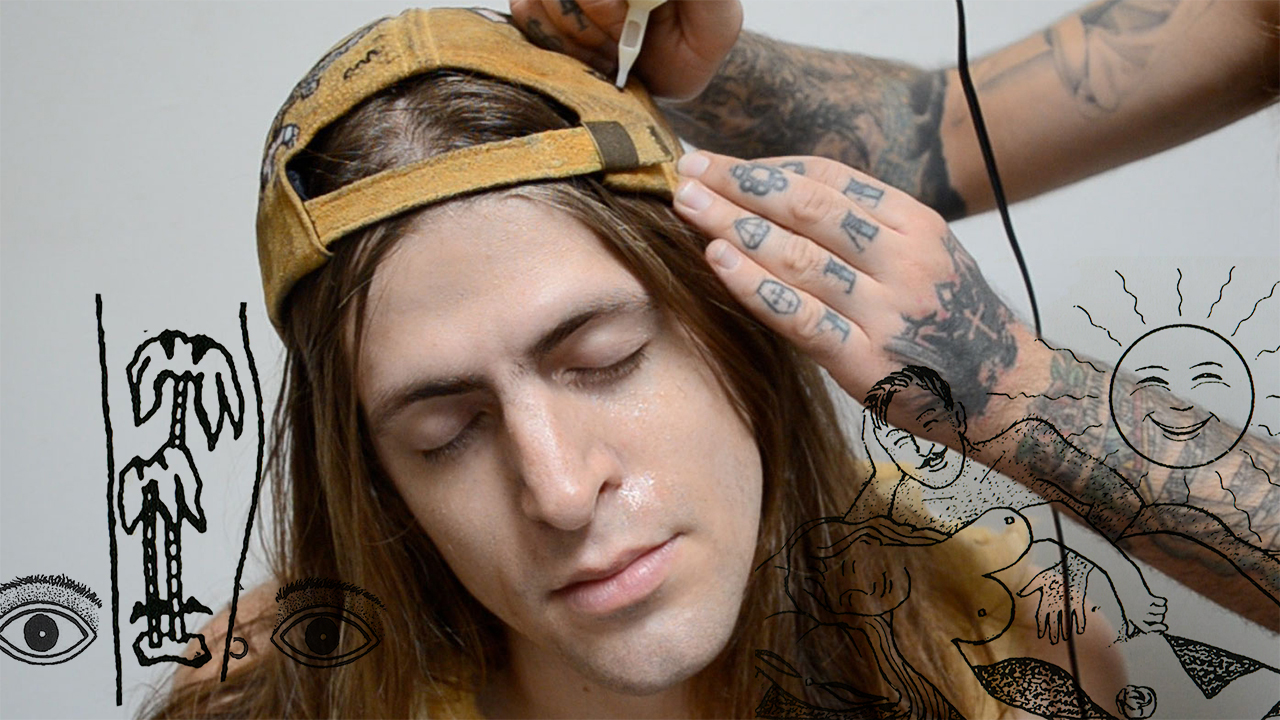ANIMAL’s feature Artist’s Notebook asks artists to show us their original “idea sketch” next to a finished artwork or project. This week, Loney Abrams and Johnny Tragedy talk about their tattoo-themed multi-disciplinary project There There.
We watch a lot of reality television. And a lot of our ideas start there. In general we’re interested in how sincere, expressive images borne from obscure subcultures become replicated, commodified and mass produced within mainstream culture. Reality shows like Jersey Shore, Duck Dynasty, Doomsday Preppers, etc., reveal how American mainstream culture chooses to understand and interpret the Other.

There’s one show in particular, which isn’t all that good, called Ink Master, in which mediocre tattooers compete to be the best “artist” by tattooing real people. Besides the obvious illustrative duality between “high art” and “low art,” tattoo culture seemed ripe for us to insert into our creative vocabulary.

Tattoos may have been devious in the 1980s, but they’ve become so visible in mainstream culture that they’ve reached the point of banality. Angelina Jolie, to us, embodies this dull edge and her tattoos show up a lot in our work.
The aesthetics of tattoo-ing have become profitable signifiers of edginess, or at least a nostalgic notion of it; tattoo typefaces market products for younger generations while tattooed models become as common as “virgin skin.” Corporate logos, like the Nike swoosh, are highly demanded tattoos, and there have been several cases of corporations offering incentives to people who become real life product placements by tattooing their skin with corporate imagery. Like anything else, the tattoo is a commodity that is able to be bought and sold. But unlike most others, the consumer is also the product. “Tattoo is a product whose consumption cannot be divorced from its production.”

We like this idea that tattoo is a fashion trend that defies its expiration date. Sociologist Mary Kosut coined this term “ironic fad,” which describes tattoos as a fad that has to remain in style because it literally can not go away. It is a forever trend.
We started playing around with a tattoo machine, tattooing leather hats, which would be permanently tattooed objects, but temporary in that they could be taken on and off the body. We tattooed UGGs and Timberlands, also products that signified distinct lifestyles or social groups that had transcended their cultural boundaries into banality.

Eventually, I think we’d like to do an entire line of tattooed clothing. But right now we are producing work that will be shown with Regina Rex at Material Art Fair (Mexico City) in February. We’re tattooing on live plants which scar, as well as leather – a material that can be made into apparel and taken on and off, yet is skin just the same. We’re stretching the leather like canvases and are creating custom pots to hold the plants. This idea of the “tattoo artist” has circled around on itself. We’re making the quintessential art product – a painting – using a process that’s significance is derived from a place of willful removal from high society.

Most of our imagery comes from one of two sources: highly visible celebrity tattoos, and obscure yet stylistically influential Russian criminal tattoos from the WWII era. Russian criminal tattoos were sometimes applied by force and were heavily loaded with political and social content. Each marking had a specific meaning – “thief,” “murderer,” “snitch,” etc – and in effect became useful identifiers among inmates. Tattoos made sense in prison. The style of these tattoos became building blocks for many contemporary styles of tattoo though they no longer hold any meaningful significance. On celebrities, or the American public in general, these images are vague. They may hold significance for the tattoo but to everyone else they all mean the same thing – conformity to the idea that tattoos are non-conformist.
 Photo credit: Lindsy Welgos, TopicalCream.info
Photo credit: Lindsy Welgos, TopicalCream.info
We map out our compositions in Photoshop pulling in images found online or scanned from a three part encyclopedia of Russian criminal tattoos.



The image we are showing you for our “final work” really consists of two works. One tattooed leather painting, and one tattooed plant. We’ve written Angelina Jolie’s tattoos on the plant. As the plant heals, the tattoos will continue to scar and become more visible.
LONELY ABRAMS AND JOHNNY TRAGEDY, THERE THERE (2013)






